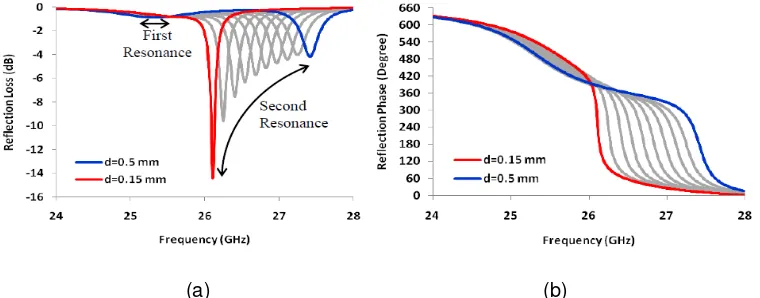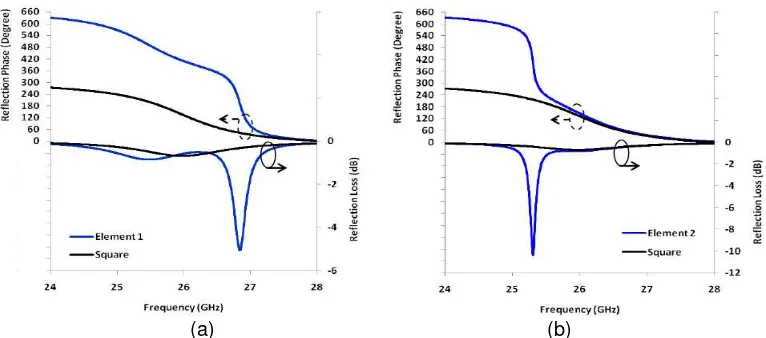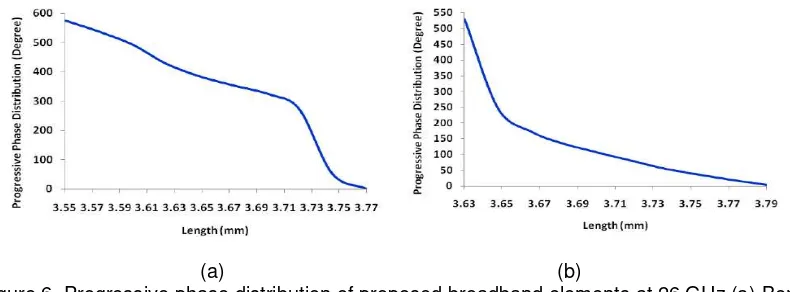Broadband Resonant Elements for 5G Reflectarray
Antenna Design
M. Hashim Dahri*1, M. R. Kamarudin2, M. H. Jamaluddin3, M. Inam4, R. Selvaraju5 Wireless Communication Centre, Faculty of Electrical Engineering, Universiti Teknologi
Malaysia, 81310 Johor Bahru, Malaysia
Corresponding author, e-mail: [email protected]*1, [email protected], [email protected], [email protected], [email protected]
Abstract
The performance investigation of two novel resonant elements is presented in this work for 5G reflectarray antenna design. Two dual resonance elements with wide reflection phase range have been developed from a square patch element by a novel corner bending tactic. The reflection loss and reflection phase range performance of the proposed elements have been compared with conventional square patch element at 26 GHz. The results have shown a reflection phase swing of 629° and 632° for Bent Width and Bent Length elements respectively. The broadband features of proposed elements can radically improve the bandwidth performance of a reflectarray antenna.
Keywords: Reflection loss, Reflection phase, Progressive phase distribution, Surface currents, Dual resonance
Copyright © 2017 Universitas Ahmad Dahlan. All rights reserved.
1. Introduction
Reflectarray antenna consists of an array of printed microstrip patches on a flat grounded dielectric substrate illuminated by a feed horn. It is a light weighted, flat and low profile antenna with beam scanning capabilities [1, 2]. It combines the best features of parabolic and phased array antennas with least possible drawbacks. Patch element which contributes as a unit cell of reflectarray plays an important role for its design realization with optimized characteristics [3-5]. The unit cell patch element is designed to reflect the incident signals coming from the feed horn into a desired direction with a planar wave front, as shown in Figure 1. The planar wave front is required to achieve high gain with pointed beam characteristics [2]. Here comes the drawback of the reflectarray antenna which restricts it to attain a planar wave front. It is the narrow bandwidth of its unit cell element with reflection phase errors [6]. The inability of unit cell element to acquire a full 360° reflection phase swing is the main reason behind the generation of differential spatial phase delays in the reflected signals. These variable time delays in reflected signals create non planar wave front and restrict them to attain high gain. The effect of phase errors is even more challenging to control at higher frequencies such as millimeter waves due to shorter wavelengths [7]. Subsequently the future fast communication systems such as 5G are proposed to work at the higher frequencies due to their high data rate requirements [8, 9]. High data rates require fast switching mechanism [10] which is only possible to attain at short wavelengths with high frequencies.
Figure 1. Reflectarray antenna operation principle
2. Design Considerations
Different frequency bands have recently been suggested for 5G communications based on their capabilities to attain required features [11]. In this work, the frequency band from 24.25 GHz to 27.5 GHz has been selected for design considerations. A resonant frequency of 26 GHz has been chosen for the designing of unit cell reflectarray. This band of frequency provides wider wavelengths compared to other proposed bands which is required particularly for less design complexity.
Figure 2. Schematics of proposed broadband elements along with a square patch element
The conventional square patch element of reflectarray antenna has been taken as a reference to propose two different broadband elements with a novel configuration. Figure 2 depicts the designs and the process of development of the proposed elements. It can be seen from Figure 2 that, the proposed novel elements have been created by bending one corner of the reference element. A bend in width at the top right corner produces Bent Width element with two different combinations of lengths and widths. Similarly, a bend in length at the same corner produces Bent Length element with a different combination of lengths and widths. The reference square patch element has same dimensions for length and width which produce a single resonant frequency. On the other hand, two different combinations of lengths and widths as in proposed designs tend to modify the E-Fields and flow of the surface currents. This modification generates two closely spaced resonant frequencies for proposed unit cell elements with broadband features. Rogers 5880 substrate with a thickness of 0.256 mm has been selected to hold the mentioned patch elements due to its optimum loss performance.
3. Results and Discussions
second resonance with extended reflection phase range is thoroughly studied. Then the results of proposed novel elements with optimized bending value are compared with the square patch element. Finally the progressive phase distribution performance of proposed broadband elements as a function of their variable size is presented.
3.1. Development of Broadband Novel Elements
The bending depth “d” as shown in Figure 2 for Bent Width and Bent Length elements has been varied gradually in order to observe the effect of the generation of a second resonance. The occurrence of a second resonance for Bent Width element starts when “d” value reaches at 0.15 mm as shown in Figure 3. It has been observed from Figure 3(a) that, as the bending depth varied from 0.15 mm to 0.5 mm the separation between the two resonances increases. Moreover, the reflection loss of second resonance also gradually decreases from 14.35 dB to 4.17 dB with increasing “d”. The generation of second resonance can also create an extra reflection phase swing as can be seen from Figure 3(b) where more than 600° of reflection phase swing has been observed.
(a) (b)
Figure 3. Effect of variable bending depth on the performance of Bent Width element (a) reflection loss (b) reflection phase
(a) (b)
Figure 4. Effect of variable bending depth on the performance of Bent Length element (a) reflection loss (b) reflection phase
Moreover, the separation between the two resonances is smaller as compared to Bent Width element. It shows that, the performance of Bent Length element is less sensitive to the bending depth as compared to Bent Width Element. Similarly, Figure 4 (b) depicts a full reflection phase swing of more than 600° due the generation of two resonances in Bent Length element. The occurrence of two resonances in both proposed elements is due to the difference in their L1 and L2 values, as depicted in Figure 2. For Bent Width element the length L1 is less than L2 which generates a second resonance at a higher frequency.
Alternatively, a second resonance at a lower frequency for Bent Length element is due to a longer L1 compared to its L2. Similarly two different widths of proposed broadband elements are responsible for the change in reflection loss performance of their second resonances. As the difference between W1 and W2 of proposed elements increases their reflection loss gradually decreases.
3.2. Optimized Performance of Broadband Novel Elements
The bending depths of proposed broadband elements have been kept constant at prescribed values in order to find an optimized performance as compared to a conventional square patch element. The bending depths have been set at 0.35 mm and 0.2 mm for Bent Width and Bent Length elements respectively. The performance comparison of proposed broadband elements with a square patch element has been depicted in Figure 5. It can be clearly observed from Figure 5 that, the reflection loss performance of both broadband elements at their first resonances is almost similar to that of square patch element. Alternatively, the reflection phase range performance of both proposed elements is considerably better than that of square patch element. Table 1 summarizes the comparison of square patch element with proposed novel elements.
(a) (b)
Figure 5. Performance comparison of proposed broadband elements with square patch element (a) Bent Width element (b) Bent Length element
Parameter Square Element Bent Width element Bent Length element
Resonant Frequency (GHz) 26 25.5 26.84 25.288 26
Reflection Loss (dB) 0.687 0.86 5.06 10.1 0.787
Max. Surface Currents (A/m) 932 1141 2221 2429 767
Full Phase Swing (°) 273 629 632
3.3. Progressive Phase Distribution
A full reflectarray antenna is made of a number of reflecting elements with a proper reflection phase distribution in order to reflect the signals with planar wave front. It is called progressive phase distribution of the elements which can be attained by varying the size of the elements [1]. Figure 6 shows the progressive phase distribution of proposed broadband elements with respect to their varying length “L1” at 26 GHz. The overall size of the proposed elements has been varied with same margins as of their length “L1”. However their bending depth values have been kept constant. As shown in Figure 6(a), Bent Width element acquired a progressive phase distribution of 575° when its length is changed from 3.55 mm to 3.77 mm. Similarly for Bent Length element a change in length from 3.63 mm to 3.79 mm attained a progressive phase distribution of 530°. This phenomenon also shows that, the reflection phase of Bent Width element is more sensitive to its dimensions as compared to Bent Length element. Additionally, the extended progressive phase distribution of proposed elements verifies their broadband features.
(a) (b)
Figure 6. Progressive phase distribution of proposed broadband elements at 26 GHz (a) Bent Width element (b) Bent Length element
4. Conclusion
The detailed analysis of development of broadband elements from a conventional square patch element has been provided. It has been shown that, broadband features can be attained by bending one corner of the square patch element. The effect of bending depth on the performance of proposed broadband elements has been thoroughly analyzed. Two different resonances can be achieved from a single element by applying the proposed technique. The generation of second resonance is solely responsible for the extension of reflection phase swing beyond 600°. The verification of results by testing will be performed in near future. The simple designs of proposed broadband elements can provide ease of fabrication at high frequencies for 5G communication. Moreover, their broadband performance can also be utilized to develop a 5G reflectarray antenna.
Acknowledgements
References
[1] Huang J, Encinar J. Reflectarray antennas. USA: Wiley Inter Science. 2007.
[2] Pozar DM, Targoski D, Syrigos HD, Targonski SD, Syrigos HD. Design of millimeter wave microstrip reflectarrays. IEEE Trans Antennas Propag. 1997; 45(2): 287-296.
[3] Pozar DM, Metzler TA. Analysis of a reflectarray antenna using microstrip patches of variable size.
Electron Lett. 1993; 29(8): 657-658.
[4] Inam M, Ismail MY. Reflection loss and bandwidth performance of X-band infinite reflectarrays: Simulations and measurements. Microw Opt Technol Lett. 2011; 53(1): 77-80.
[5] Dahri MH, Ismail MY. Phase Distribution Analysis of Reflectarray Resonant Elements based on Linear and Non-linear Materials. In International Symposium on Telecommunication Technologies (ISTT2012). Kuala Lumpur, Malaysia. 2012.
[6] Pozar DM, Targonski SD, Syrigos HD. Analysis and design of millimeter wave microstrip reflectarrays. IEEE Antennas Propag Soc Int Symp. 1995; 1(2): 287-296.
[7] Jamaluddin MH, Sauleau R, Castel X, Benzerga R, Le Coq L, Gillard R, et al. Design, Fabrication and Characterization of A Dielectric Resonator Antenna Reflectarray In Ka-Band. Prog Electromagn Res B. 2010; 25: 261-275.
[8] Boccardi F, Heath R, Lozano A, Marzetta T. L, Popovski P. Five disruptive technology directions for 5G. IEEE Commun Mag. 2014; 52(2): 74-80.
[9] Andrews JG, Buzzi S, Choi W, Hanly SV, Lozano A, Soong ACK, et al. What will 5G be? IEEE J Sel Areas Commun. 2014; 32(6): 1065-1082.
[10] Wonbin H, Kwang-Hyun B, Youngju L, Yoongeon K, Seung-Tae K. Study and Prototyping of Practically Large-Scale mmWave Antenna Systems for 5G Cellular Devices. IEEE Commun Mag. 2014: 63-69.



